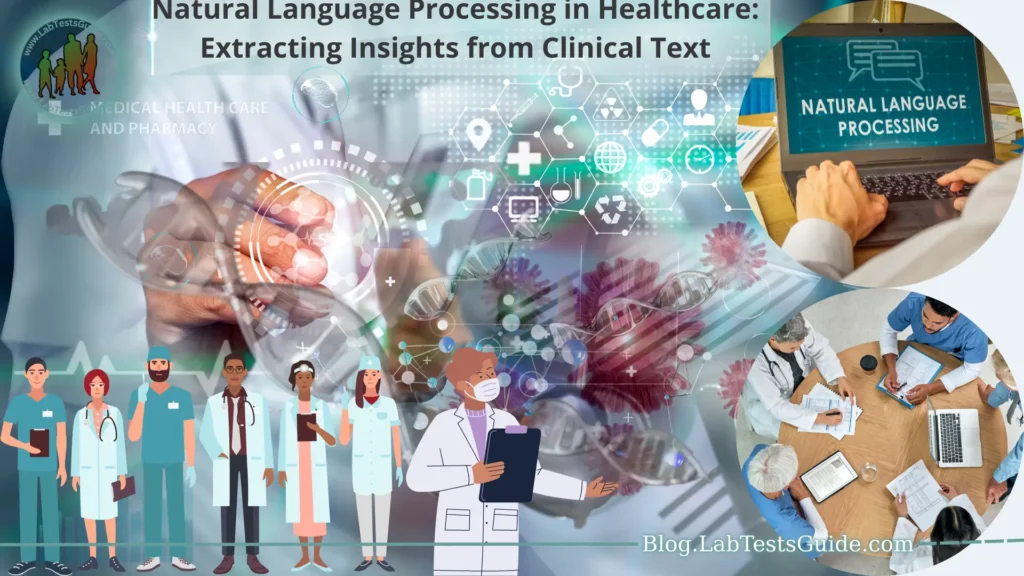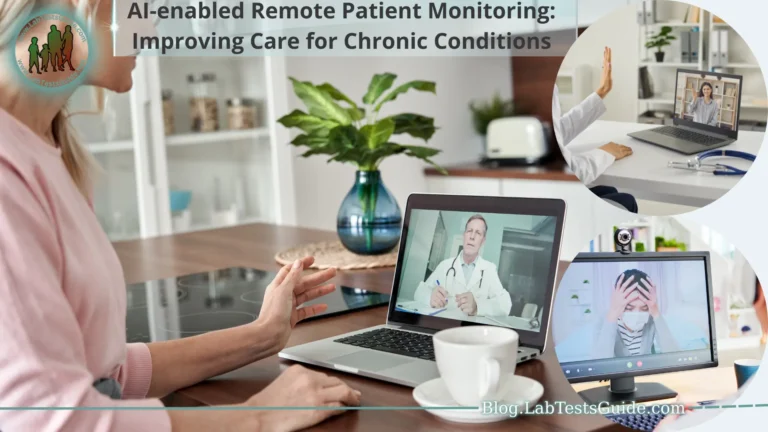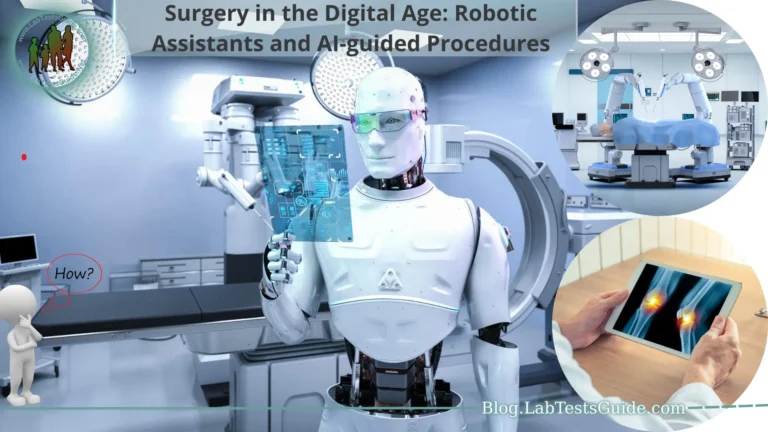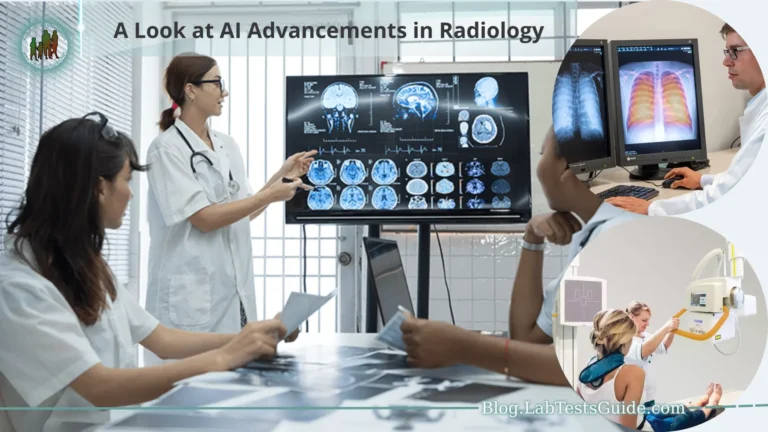Natural Language Processing (NLP) in healthcare involves the application of computational techniques to analyze, interpret, and generate human language in a way that is valuable for healthcare practitioners, researchers, and administrators. Clinical text, which includes electronic health records (EHRs), medical notes, radiology reports, pathology reports, and other medical documents, is a rich source of information that can provide valuable insights when processed using NLP techniques.

What Is Natural Language Processing (NLP) in Healthcare?
Introduction to NLP in Healthcare:
- Natural Language Processing (NLP) is a branch of artificial intelligence (AI) focused on enabling computers to understand, interpret, and generate human language.
- In healthcare, NLP involves applying computational techniques to analyze and extract meaningful information from clinical text, such as electronic health records, medical reports, and patient notes.
Unstructured Clinical Text:
- Clinical text often contains unstructured data, including medical narratives, notes, and reports written by healthcare professionals.
- NLP algorithms are used to process this unstructured text, transforming it into structured, actionable data.
Information Extraction:
- NLP techniques enable the automated extraction of important medical information from clinical text, such as patient demographics, diagnoses, treatments, medications, and procedures.
- This structured information can be used for various purposes, including clinical decision support, research, and reporting.
Clinical Coding and Classification:
- NLP assists in assigning appropriate medical codes, such as ICD-10 codes, to diagnoses and procedures mentioned in clinical text.
- Accurate coding improves billing, reimbursement, and disease tracking processes.
Clinical Decision Support:
- NLP-powered clinical decision support systems analyze clinical text to provide healthcare professionals with relevant information at the point of care.
- This includes alerts about drug interactions, allergies, evidence-based treatment options, and clinical guidelines.
Predictive Analytics and Research:
- NLP is used for predictive analytics, identifying patterns and risk factors in clinical text data to predict patient outcomes, disease progression, and complications.
- Researchers use NLP to identify patient cohorts for clinical studies and trials, enhancing recruitment and accelerating research.
Patient Monitoring and Surveillance:
- Real-time analysis of clinical text data using NLP supports patient monitoring in intensive care units (ICUs) and other clinical settings.
- NLP systems can automatically detect critical changes in a patient’s condition and provide timely alerts.
- Semantic Search and Information Retrieval: NLP-powered search engines improve the efficiency and accuracy of retrieving relevant information from medical literature, databases, and electronic health records.
- Sentiment Analysis and Patient Feedback: NLP techniques analyze patient feedback and sentiment from textual data, helping healthcare providers enhance patient experiences and services.
- Population Health Management: NLP aids in analyzing population-level health trends, estimating disease prevalence, and informing public health strategies and resource allocation.
How to Harness Natural Language Processing (NLP) for Extracting Healthcare Insights from Clinical Text:
Understand NLP Fundamentals:
- Familiarize yourself with the basics of Natural Language Processing (NLP) and its applications in healthcare.
- Learn about NLP techniques such as tokenization, part-of-speech tagging, named entity recognition, and sentiment analysis.
Collect and Prepare Clinical Text Data:
- Gather a diverse and representative dataset of clinical text, including electronic health records, medical reports, and notes.
- Preprocess the data by removing noise, normalizing text, and handling special characters and formatting issues.
Select or Build an NLP Tool or Framework:
- Choose an NLP tool or framework suitable for your project, such as spaCy, NLTK, or Hugging Face Transformers.
- Consider building custom NLP models if your specific healthcare domain requires specialized knowledge.
Data Annotation and Labeling:
- Annotate and label the clinical text data with relevant categories, such as diagnoses, medications, procedures, and patient demographics.
- Create a labeled dataset for training and evaluating your NLP models.
Train and Fine-Tune NLP Models:
- Train NLP models using your labeled dataset to perform tasks like named entity recognition (NER) and relation extraction.
- Fine-tune pre-trained language models (e.g., BERT, GPT-3) on clinical text to leverage their contextual understanding.
Information Extraction and Coding:
- Develop NLP pipelines to extract structured information from clinical text, including medical codes (e.g., ICD-10) for diagnoses and procedures.
- Implement rule-based or machine learning-based approaches for accurate information extraction.
Clinical Decision Support System Integration:
- Integrate your NLP-powered insights into clinical decision support systems used by healthcare professionals.
- Develop alerts for drug interactions, treatment recommendations, and evidence-based guidelines.
Predictive Analytics and Research:
- Build predictive models using NLP-processed clinical text to forecast patient outcomes and disease progression.
- Implement techniques like sequence modeling, time-series analysis, and risk stratification.
Real-Time Patient Monitoring:
- Deploy NLP models for real-time patient monitoring in clinical settings like ICUs.
- Develop algorithms to identify critical changes and send automated alerts to healthcare providers.
Semantic Search and Retrieval:
- Create an NLP-powered search engine for efficient retrieval of relevant information from medical literature and databases.
- Implement semantic search techniques to improve search accuracy.
Information Extraction from Clinical Text:
Understanding Information Extraction:
- Information extraction involves automatically identifying and extracting structured data from unstructured clinical text, such as electronic health records and medical reports.
- Extracted data may include patient demographics, diagnoses, medications, procedures, and treatment plans.
Preprocessing Clinical Text:
- Clean and preprocess clinical text by removing noise, formatting issues, and special characters.
- Normalize text by converting it to lowercase and handling abbreviations and synonyms.
Tokenization:
- Tokenize the clinical text into individual words, phrases, or subword units.
- Splitting the text into tokens forms the basis for further analysis.
Named Entity Recognition (NER):
- Implement NER to identify and classify named entities, such as diseases, medications, procedures, and patient names, in the clinical text.
- Train NER models using labeled data and consider using pre-trained NER models for general medical terms.
Relation Extraction:
- Extract relationships between identified entities. For example, connecting a disease entity with a corresponding treatment entity.
- Develop rules or machine learning models to recognize these relationships.
Rule-Based Extraction:
- Create domain-specific rules to extract information based on patterns, keywords, or syntactic structures.
- For example, use regular expressions to capture dates, lab results, and other structured data.
Machine Learning-Based Extraction:
- Train machine learning models, such as conditional random fields (CRF) or sequence labeling models, to perform information extraction tasks.
- Annotate clinical text with labeled data to train and evaluate these models.
Normalization and Standardization:
- Normalize extracted data by mapping synonyms and abbreviations to standardized terms.
- Link extracted entities to medical ontologies (e.g., SNOMED CT, RxNorm) for consistent representation.
Entity Resolution:
- Handle cases where the same entity may be mentioned differently in different parts of the text (e.g., “aspirin” vs. “acetylsalicylic acid“).
- Use entity resolution techniques to link these mentions to a single, canonical representation.
Validation and Evaluation:
- Validate the accuracy of your information extraction methods by comparing the extracted data with ground truth or manual review.
- Calculate metrics like precision, recall, and F1-score to assess the model’s performance.
Clinical Coding and Classification:
Introduction to Clinical Coding and Classification:
- Clinical coding involves the assignment of standardized codes to medical diagnoses, procedures, treatments, and other healthcare-related information.
- Classification systems, such as ICD-10 (International Classification of Diseases, 10th Revision) and CPT (Current Procedural Terminology), provide a structured framework for coding medical data.
Importance of Accurate Coding:
- Accurate clinical coding is essential for billing, reimbursement, healthcare management, epidemiological research, and public health monitoring.
- It ensures consistency, interoperability, and efficient data exchange across healthcare systems.
NLP in Clinical Coding:
- Natural Language Processing (NLP) can enhance the clinical coding process by automating the extraction and assignment of codes from unstructured clinical text.
Data Preparation for Coding:
- Collect and preprocess clinical text data, ensuring it is clean, normalized, and relevant to the coding task.
- Tokenize and structure the text to facilitate code extraction.
Code Assignment for Diagnoses and Procedures:
- Develop NLP models to automatically identify and assign appropriate codes from clinical text for diagnoses (ICD-10) and procedures (CPT).
- Train models using annotated data, considering fine-tuning of pre-trained language models.
Rule-Based Coding Approaches:
- Create rule-based systems to map clinical concepts mentioned in text to standardized codes.
- Utilize patterns, dictionaries, and expert-defined rules for accurate code assignment.
Handling Ambiguity and Specificity:
- Address challenges posed by ambiguous terms and context-specific interpretations in clinical text.
- Develop mechanisms to resolve ambiguity and assign the most relevant code based on clinical context.
Cross-Referencing and Validation:
- Cross-reference extracted codes with medical ontologies and classification systems to ensure correctness and standardization.
- Implement validation steps to verify the accuracy of assigned codes.
Integration with Healthcare Systems:
- Integrate NLP-powered coding solutions with electronic health record (EHR) systems, billing software, and healthcare databases.
- Facilitate seamless communication between coding systems and other healthcare applications.
- Continuous Learning and Adaptation: Continuously update NLP models and coding rules to accommodate evolving medical terminology, updates to coding systems, and changes in healthcare practices.
Clinical Phenotyping and Cohort Identification:
Introduction to Clinical Phenotyping and Cohort Identification:
- Clinical phenotyping involves defining and characterizing patient populations based on specific clinical attributes, characteristics, and patterns.
- Cohort identification refers to the process of selecting and assembling patient groups for research or clinical purposes.
Importance of Phenotyping and Cohort Identification:
- Clinical phenotyping and cohort identification are critical for understanding disease patterns, conducting research studies, and tailoring patient care strategies.
NLP’s Role in Phenotyping and Cohort Identification:
- Natural Language Processing (NLP) plays a vital role in automating and enhancing the process of defining clinical phenotypes and identifying patient cohorts from unstructured clinical text.
Defining Clinical Phenotypes:
- Collaborate with domain experts to define clinical phenotypes, specifying relevant criteria, symptoms, diagnoses, treatments, and other characteristics.
- Use NLP to extract and categorize relevant information from clinical text, contributing to phenotype definition.
Extracting Clinical Features:
- Develop NLP pipelines to extract clinical features and attributes associated with specific phenotypes, such as lab values, medications, and vital signs.
- Apply named entity recognition (NER) and relationship extraction to identify relevant information.
Phenotype Algorithm Development:
- Create algorithms that combine extracted clinical features to identify patients with specific phenotypes.
- Consider rule-based, machine learning, or hybrid approaches for accurate phenotype detection.
Cohort Identification for Research:
- Use NLP to identify patient cohorts for research studies by selecting individuals who meet specific phenotype criteria.
- Automate the identification process to efficiently assemble cohorts from large clinical datasets.
Patient Data Integration:
- Integrate NLP-derived phenotypic information with electronic health records and clinical databases to ensure comprehensive patient profiles.
- Establish data linkage mechanisms for accurate cohort identification.
Clinical Trial Recruitment:
- Utilize NLP-powered cohort identification to identify potential participants for clinical trials based on specific phenotypes.
- Enhance recruitment efficiency by automating the identification of eligible patients.
Validation and Quality Assurance:
- Collaborate with healthcare experts to validate the accuracy and clinical relevance of NLP-generated phenotypes and cohorts.
- Implement quality control measures to ensure reliable results.
Predictive Analytics in Healthcare:
Introduction to Predictive Analytics in Healthcare:
- Predictive analytics involves using historical data and statistical algorithms to forecast future outcomes and trends.
- In healthcare, predictive analytics leverages patient data to anticipate disease progression, patient outcomes, and resource needs.
Importance of Predictive Analytics in Healthcare:
- Predictive analytics enables early intervention, personalized treatment plans, and optimized resource allocation, leading to improved patient outcomes and cost savings.
Data Collection and Preparation:
- Gather comprehensive and high-quality patient data, including electronic health records, medical imaging, lab results, and wearable device data.
- Clean, preprocess, and normalize the data to ensure consistency and accuracy.
Feature Engineering:
- Identify relevant features (variables) from the data that are predictive of the outcomes of interest.
- Perform feature engineering techniques, such as dimensionality reduction and feature selection, to enhance model performance.
Model Selection:
- Choose appropriate predictive modeling techniques based on the problem at hand, such as regression, classification, time-series analysis, or survival analysis.
- Explore traditional statistical models and machine learning algorithms, considering the interpretability and complexity of the model.
Machine Learning Algorithms:
- Implement machine learning algorithms like decision trees, random forests, support vector machines, and gradient boosting for predictive modeling.
- Utilize deep learning models, such as neural networks, for complex patterns and data representations.
Temporal Analysis and Time-Series Forecasting:
- Account for temporal relationships in healthcare data by applying time-series analysis and forecasting techniques.
- Predict disease progression, patient deterioration, and treatment responses over time.
Feature Importance and Interpretability:
- Evaluate the importance of features to understand their impact on predictive outcomes.
- Employ techniques like feature importance scores and SHAP (SHapley Additive exPlanations) values for model interpretability.
Model Training and Validation:
- Split the data into training and validation sets to train and evaluate the predictive models.
- Use techniques such as cross-validation and hyperparameter tuning to optimize model performance.
Patient Monitoring and Surveillance:
Introduction to Patient Monitoring and Surveillance:
- Patient monitoring and surveillance involve continuous or periodic tracking of patients’ health indicators, vital signs, and clinical data to ensure timely intervention and proactive care.
- Importance of Patient Monitoring and Surveillance: Continuous monitoring enhances patient safety, enables early detection of deteriorating conditions, and facilitates prompt medical interventions.
- Role of NLP in Patient Monitoring: Natural Language Processing (NLP) contributes to patient monitoring by analyzing unstructured clinical text, generating alerts, and supporting real-time decision-making.
Data Sources and Integration:
- Gather data from various sources, including electronic health records, wearable devices, medical sensors, and real-time clinical text.
- Integrate NLP pipelines to process and extract valuable insights from unstructured clinical narratives.
Real-Time Data Streams:
- Process and analyze real-time data streams from patient monitors, wearable devices, and other sensors.
- Implement data processing pipelines capable of handling high-frequency updates.
Early Warning Systems:
- Develop early warning systems that monitor vital signs, lab results, and clinical narratives for signs of deterioration or critical changes.
- Utilize NLP to analyze text data for subtle indicators of potential health risks.
Automated Alert Generation:
- Use NLP to automatically generate alerts and notifications for healthcare providers when abnormal or critical conditions are detected.
- Alerts can be based on predefined rules, machine learning models, or a combination of both.
Contextual Information Extraction:
- Apply NLP techniques to extract contextual information from clinical text, such as patient history, allergies, and recent interventions.
- Enhance alerts with relevant patient context for informed decision-making.
Severity and Risk Assessment:
- Develop models that assess the severity and risk level of detected conditions based on both structured and unstructured data.
- Incorporate NLP-derived insights to enhance risk stratification.
Population Health Management:
Introduction to Population Health Management:
- Population health management (PHM) is a proactive approach to improving the health and well-being of a defined group or population.
- It involves assessing health risks, implementing interventions, and tracking outcomes to enhance overall health.
Importance of Population Health Management:
- PHM focuses on preventive care, chronic disease management, and addressing health disparities, leading to better health outcomes and reduced healthcare costs.
- Role of NLP in Population Health Management: Natural Language Processing (NLP) contributes to PHM by analyzing clinical text, identifying trends, and generating insights from diverse data sources.
Data Collection and Integration:
- Gather data from various sources, including electronic health records, claims data, public health records, and social determinants of health.
- Integrate structured and unstructured data for a comprehensive view of population health.
Risk Stratification and Prediction:
- Develop risk stratification models using both structured and NLP-derived features to identify high-risk individuals and target interventions effectively.
- Utilize NLP to analyze clinical text for subtle risk factors and patient characteristics.
Disease Surveillance and Outbreak Detection:
- Use NLP to monitor and analyze clinical narratives for disease outbreaks, emerging trends, and potential public health threats.
- Enhance real-time surveillance capabilities through text analysis.
Identifying Health Disparities:
- Apply NLP to identify health disparities based on socio-economic factors, geographic location, and access to care.
- Tailor interventions to address specific needs within the population.
- Public Health Interventions: Implement interventions based on NLP-driven insights, such as targeted vaccination campaigns, preventive screenings, and health education programs.
Social Determinants of Health:
- Analyze social determinants of health (e.g., housing, income, education) from clinical text to better understand population health dynamics.
- Develop strategies to address social determinants and improve health equity.
Care Coordination and Outreach:
- Utilize NLP to identify individuals in need of care coordination and outreach.
- Generate alerts for care teams to engage with patients and provide appropriate interventions.
FAQs:
What is Natural Language Processing (NLP) in Healthcare?
NLP in healthcare involves using AI and computational techniques to analyze and understand human language in clinical text, enabling insights extraction, decision support, and research.
How does NLP assist in Information Extraction from Clinical Text?
NLP techniques help extract structured data from unstructured clinical text, including patient demographics, diagnoses, medications, and procedures, improving data utilization and accuracy.
What role does NLP play in Clinical Coding and Classification?
NLP aids in automating medical coding tasks, such as assigning ICD and CPT codes to diagnoses and procedures, improving billing accuracy and streamlining reimbursement processes.
How does NLP contribute to Clinical Decision Support Systems?
NLP-powered clinical decision support provides alerts, drug interaction detection, and evidence-based treatment recommendations, assisting healthcare providers in making informed decisions.
What is Clinical Phenotyping, and how does NLP enhance it?
Clinical phenotyping involves characterizing patient groups based on attributes. NLP helps extract and analyze clinical text to refine phenotypes and accelerate research.
How can Predictive Analytics be applied in Healthcare with NLP?
Predictive analytics in healthcare uses historical data and NLP insights to forecast patient outcomes, disease progression, and complications, aiding early intervention and personalized care.
How does NLP contribute to Patient Monitoring and Surveillance?
NLP enhances patient monitoring by analyzing real-time clinical text, generating automated alerts for critical changes, and supporting real-time decision-making.
What is the significance of NLP in Semantic Search and Information Retrieval?
NLP-powered semantic search improves the efficiency and accuracy of retrieving relevant medical information from literature, databases, and electronic health records.
How does NLP analyze Sentiment and Patient Feedback in Healthcare?
NLP analyzes patient sentiment from textual feedback to improve patient experience and service quality, enhancing healthcare provider-patient interactions.
What is Population Health Management, and how is NLP utilized?
Population health management involves proactive healthcare strategies. NLP contributes by analyzing data to identify trends, assess risks, and tailor interventions for a defined population.
Conclusion:
In conclusion, the integration of Natural Language Processing (NLP) within the healthcare domain has ushered in a transformative era of data-driven insights and improved patient care. Through its ability to extract valuable information from unstructured clinical text, NLP empowers healthcare professionals with efficient clinical coding, accurate phenotyping, predictive analytics, and real-time patient monitoring. These advancements not only streamline administrative processes and enhance clinical decision-making but also pave the way for personalized medicine, population health management, and the potential to revolutionize healthcare delivery. As NLP continues to evolve alongside emerging technologies, its role in unlocking the full potential of healthcare insights from clinical text remains integral to shaping the future of medical practice and patient outcomes.






